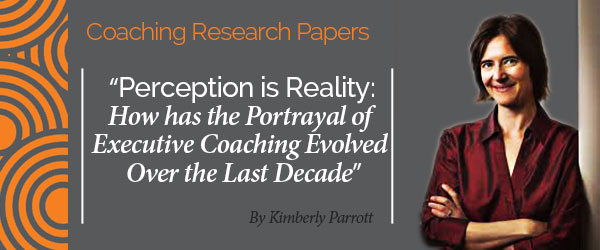 Research Paper By Kimberly Parrott
Research Paper By Kimberly Parrott
(Executive Coach, UNITED STATES)
How has the portrayal of executive coaching evolved over the last decade?
Background
Executive coaching is a young industry still taking shape. It derives from sports coaching where athletes achieved significant performance gains when the coaching focus was on the athlete’s “inner game”, or psychological mindset. The business world took notice and hired savvy sports coaches to work with their executives. Over time, executive coaching became its own niche.[1]
How have perceptions about executive coaching evolved over the last decade? How is it currently being portrayed in the business community? What better source for gauging that evolution than the Harvard Business Review (HBR), which has positioned itself as
the leading destination for smart management thinking.
I have selected five articles from the HBR magazine and five blogs from the HBR website that span the last decade as a way to assess if there has been a noticeable shift in how executive coaching is portrayed and perceived in business. I will briefly summarize each article and blog in chronological order and then present any patterns that I have observed. I will also describe what I think are the implications for executive coaching based on these trends.
Synopses
1. Article: The Very Real Dangers of Executive Coaching, Steven Berglas, June 2002
Steven Berglas is a doctor in psychology as well as an executive coach. He sounds the alarm about the difference between “problem executives” whose behaviors can be modified and “executives with problems” who would best be served by psychotherapy. Berglas’s concern is that too many executive coaches don’t have a background in psychology and therefore may fail in identifying clients suffering from serious mental health disorders. He argues for psychological screening for prospective executive coachees as well as a review of coaching outcomes by independent mental health professionals.
2. Article: Behave Yourself, conversation with Marshall Goldsmith Oct 2002
Marshall Goldsmith, widely considered a guru in executive coaching, discusses the most common behavioral issues he sees in executives: an obsession with winning coupled with a focus on winning oneself vs. making others winners. He provides pointers on what to look for in hiring an executive coach. Good coaches specialize but at the same time are facilitative rather than consultative. It is the executive’s responsibility to make the change, not the coach’s. The “real” coaches are the people surrounding the executive. The measurement of coaching success is in the perception of behavioral change as seen by those people—customers, colleagues, friends and family.
3. Article: Coaching the Alpha Male, Kate Ludeman & Eddie Erlandson, May 2004
Kate Ludeman and Eddie Erlandson lay out the challenges and opportunities of coaching alpha males. The very qualities that led to their success (i.e. confidence, intelligence, action oriented, direct, unemotional) make these individuals difficult to work with. Alpha males can be excellent midlevel managers where they are managing processes, but as they move up into the executive ranks, they need to transition into leading people. Coaching the alpha male requires a focus on results, an analytic orientation and a direct style of communication. 360 feedback reports are an effective way to get the alpha male’s attention. Feedback should be hard hitting both quantitatively and through verbatim quotes. Ultimately the client’s curiosity and competitive instincts need to be engaged to get his commitment. While there are many successful female leaders with strong personalities, their profiles don’t generally include all of the alpha male attributes; they are more likely to use the “velvet hammer” vs. direct intimidation. Coaching can help the alpha male grow as he learns to admit vulnerability, accept accountability, connect with underlying emotions, balance critical with positive feedback and become aware of behavioral patterns.
4. Article: Wild West of Executive Coaching, Stratford Sherman & Alyssa Freas, November 2004
Stratford Sherman and Alyssa Freas describe the landscape of executive coaching in 2004 as
chaotic, largely unexplored, and fraught with risk, yet immensely promising.
Solid data regarding outcomes was lacking since companies had only started working with executive coaching in the 1980s. The authors continue on to describe why executive coaching works as a customized way to engage senior leaders as individuals. Sherman and Freas describe the “coaching triangle” which reflects the relationship between the coach, the coachee and the client that pays the bills. A rigorous contracting and iterative action-planning process that includes all three parties helps to ensure quality results. The authors stress the need to qualify each part of the triangle. Successful coaches embody
acute perception, diplomacy, sound judgment, and the ability to navigate conflicts with integrity.
The coachee needs to be motivated, coachable, supported by the organization and worthy of the coaching investment cost. Finally, the paying client needs to command top-level support for the coaching process. The authors stress that quality results depend on being able to measure coaching goals. They describe how they have created custom mini-360 assessments particular to specific coaching goals. They close by advocating for the value of coaching an organization’s entire senior executive team, with individual coaching relationships serving that larger strategic objective.
5. Blog: Political Correctness and the Executive Coach, Gill Corkinday, March 21, 2007
Gill Corkinday describes facilitating a feedback session between five executives from five very different cultures. To her surprise the exchange went from a collegial conversation to a minefield on account of metaphors that crossed the lines of political correctness around gender, ethnicity, looks, age and religion. Corkinday found herself intervening to control the damage by substantially rephrasing the feedback. She recalls the definition of PC: “a term used to describe language or behavior which is intended, or said to be intended, to provide a minimum of offense, particularly to racial, cultural, or other identity groups.” She realizes that despite her earlier resistance to the censure of the PC movement, it has its place, and must also be balanced with the need to honor cultural differences.